Sometimes guitars are just so cool that you wonder what it must have been like to be a kid and see them hanging on the wall of a department store. I mean, there were guitars like this all over in the 1960s! These Kent guitars are so interesting to me and really deserve some recognition.

These Kent guitars were a real departure from what was being branded with the Kent name previously. These “700” models had some really cool and tasteful features that were never seen before or since. These guitars just look classy! The inlaid “Kent” on the upper horn of the body, and the RACING STRIPES along the edges! There’s binding all over, and all kinds of shiny pearloid inlays on the neck, and headstock. And check out the flame figuring in the wood! That’s something not often seen on vintage Japanese guitars.
Apparently that neck plate is a tell-tale giveaway that it’s late 60s Kawai or Teisco built, and man, did they ever build some cool guitars during this period! The Kent 700 series came in all sorts of variations and prices, and here’s a quick rundown of 1968 specs and prices:
- 740 – Double pickup w/ Kent Tremolo $110, or with optional Bigsby for $165
- 741 – Triple pickup w/ Kent Tremolo $120
- 742 – Four pickup w/ Kent Tremolo $130
- 745 – 12 String Double Pickup $130
- 743 – Bass double pickup $120
- 744 – Electric Mandolin with single pickup $85
All guitars were available in left handed models for an extra $10 and available finishes were white, blonde, yellow sunburst, and cherry red. I have to laugh when I see online auctions claim that white was a “custom order” color and of course you should pay TWICE the amount for the “rare” custom shop Kent. HAHAHA!!! Curiously, Bigsby tremolos were offered on these guitars, but only on the yellow sunburst finish.
All the Kent tremolos had that bridge mute attached, and overall the Kent units are really effective. The tuners are serviceable and the pickups read out at 9.02k for the bridge and 9.17k for the neck. That’s some really good output! Unfortunately, the wiring scheme is not optimal or series and with both pickups on the output drops to 4.55k, so this is an example of less is more. Meaning, the two pickup model is the most desirable from a player’s standpoint. Plus when you see the four pickup model, the switches and knobs are really crammed onto the pick guard! There’s also a rhythm/solo switch, and I have to say it sounds better in the rhythm position. It just gives the guitar more oomph!
Notice the little “Kent” lettering on the pickups? There’s little tasteful (or tacky) touches like that all over! Strapping on one of these Kent 700 guitars is sort of different. Like, it feels like a semi-hollow body guitar at first. But the bodies are rather heavy and feel solid. In comparison, the necks are on the thin side. The bodies are 14″ wide and 19″ long, and the bodies are 1 3/8″ thick. Those horns are really pleasing to my eye, but the racing stripes are where it’s at! The 1968 Kent catalog described the styling as “Rally Stripes.” The stripes seem like strips of vinyl glued around the sides and then lacquered over, but I could be wrong about that. The stripes are definitely not made of wood!

Kent also hyped their “New” oval-shaped fingerboard. The text read:
“Completely new Kent fingerboard fits your hand like a glove….moves like a fine tuned Sting Ray! Fine rosewood with nickel-silver frets, on 3-piece neck of African mahogany and top grade maple. Positive-action neck adjusting rod is easy to reach. Try this fingerboard for size!”
Notice all the hot-rod imagery? The 1968 catalog was also high on beach parties and surfboards!
So basically you have a really cool looking guitar with all sorts of “hip” appointments, but I have to say when I got this guitar it was just about unplayable! The bridge had tilted forward, the frets were uneven, the neck was warped, and worst of all, the electronics just did absolutely no favors for the guitar’s sound! I wonder if anyone was upset after they brought one of these home? As usual, the volume pot values were too low (choking the output), and the tone switch cap further strangled some of the output. Lastly, the neck angle and fretboard radius had strings buzzing all over the place! Dano once again is the MAN when it comes to breathing life into these beauties and I’m not exaggerating when I say Dave is a miracle worker! Now this guitar could be played out on a nightly basis with no worries! I’m telling you people, check this guy out if you have an awesome guitar that plays a lot less than awesome!
So how do these sound? Well, after they’re dialed in, they sound GREAT!! Check out the video we did with Mike Dugan playing the Kent 740 through a vintage Ampeg Gemini I and a Fulltone OCD for some grit!
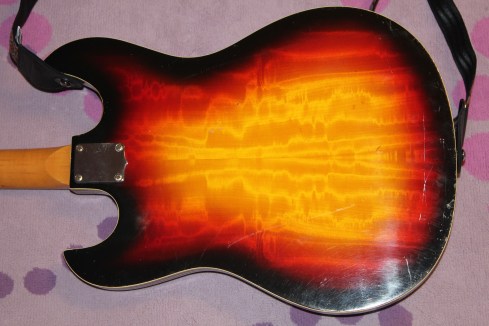
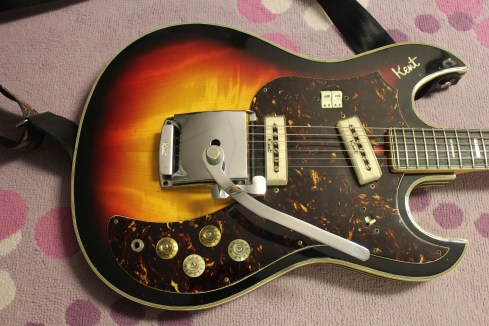
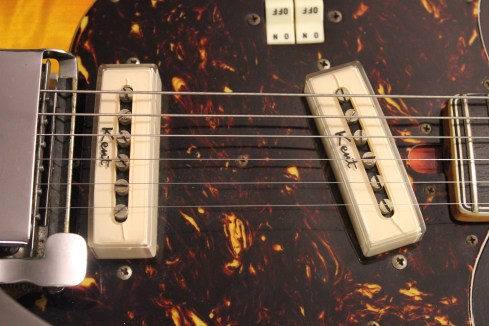
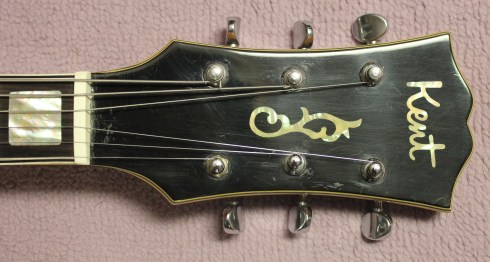
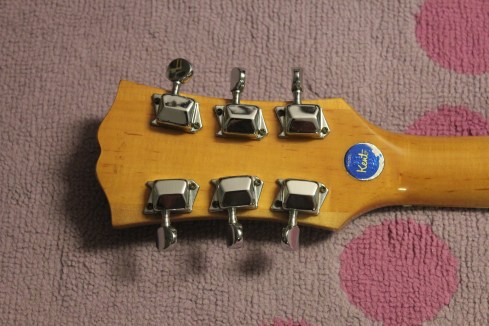
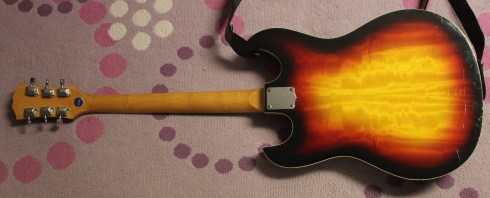
I have a Kent 740 (left hand). I have to say I like this guitar very much. And being lefthanded, it gives me a real unusual choice. My other guitar being a strat.
Yep, I like mine a lot too. Left handed options at that time were really limited. Mike Dugan, the player that does our video demos, is actually a lefty. As a kid, he didn’t even realize there were lefty guitars, so he just learned to play right-handed. It wasn’t until he saw the Beatles on TV that he noticed something odd about the way Paul played bass!!! True story!!
Just wondering if you had a couple of kent parts laying around maybe.
I was wondering if you might have a couple pieces I’m looking for. I am looking for the Kent emblem that is spelled in cursive that goes on neck by the tuning keys, also need a kent tremolo cover and spring. Cover is chrome with white “KENT” letters on it. Thanks. Greg.
Sorry man, my parts bin has just about run dry. But if you leave your email address on here maybe somebody cruising by will notice and be able to help you out?
hi, I’m loooking for a Kent 740 left handed, could you tell me if you can help to find it, cheers from France, alain
Hi Alain, these are extremely hard to find. If I do find another, I’ll let you know.
Had one as a Kid. Kick myself every day for letting it go. Been searching for a 740 in either red or Sunburst.
Gus I just found a 740 Sunburst in pretty good condition. Are you interested? If so post a reply and I will give my email address
I believe the kent guitar was Bruce Springsteens first guitar and that God for that the rest is history.
PureSalem guitars here …. This guitar is on the “to do list” for future production. I think we will add a maestro vibrato and keep it simple with two humbucker pickups. We plan on opening in mid 2013. Also, all our guitars will be avaiable in a lefty version at no additional cost. When we are up and running we will have a request page for limited run model productions. We suffered a setback with our first manufacturer so that has delayed our opening date but were back on track.
I got one of these for Christams in 1966, I was 12. Looked exactly like the one pictured here. Great looking instrument that didn’t play worth a damn. Worked hard to get it playable, and played it for the next 5 years. Gave it away after picking up a Hagstrom II. If my old friend “Ravi” still has it, I hope he’s taking care of it.
I have one of these in excellent condition. What is the value of it now days.
Ballpark would be $200-$300. If you’re going to sell, let me know!
nice page! I got here searching for other Kent guitar sites. I have a site about the Kent 820 guitar, http://www.kent-820.com .With your permission I’m going to put a link in my site to this page, otherwise let me know.
Sure man, I’d be happy to support your site! BTW, I checked it out, and keep up the work man, very nice.
thanks ! I’ve been collecting Kent 820 guitars for 15 years, they are really good guitars.
Cool!
the Kent 740 is a solid body guitar. it has stripes on the side.
do those stripes represent layers of wood inside the guitar
when it was designed and assembled?
No one is sure where these were made yet. I’ll figure it out eventually. The binding rally stripes on this model are like a wrap, on top of the wood rather than embedded. Does that make sense?
so the center stripe or binding on the sides is what is called an “appliqué” ? in other words, the wood is not routed first and then the binding glued?
That’s right, applique is a good way to describe it. But here’s the kicker, the binding technique varied on these late 60s Kent models. The binding is different on the hollowbody guitars, which may point to these Kent models being produced at more than one factory.
that’s what I thought, because in the 820 models I thought it was a routing on the wood of the sides, onto which a strip of flat celluloid binding was glued, just like the binding on the edges. I could be wrong, I haven’t had to fix the binding in any of my 820. Regardless, I think they did a wonderful job, these guitars have lasted 45+ years without issues. Thanks.
On the hollows, it’s almost as if the binding is there to cover the seam where the top and bottom of the bodies come together. In their day, this striped binding was considered a slightly sophisticated technique. Definitely a cut above the average Japanese import of the time.
cool guitar is it still for sale? if so how much? im interested.
Sorry man, this one’s sold already.
I have one that I’m looking to restore. Wiring needs to be redone. Any schematics available?
Hello!
I have a Kent 820 but it’s missing some parts. Tone knob, tremolo arm and tremolo spring.
Anyone know where I can buy these parts?
Thanks!
ebay, and old skool guitar shops are the best bets.
I have a Tone knob and a tremolo spring (it’s actually called Vibrato), all I have to do is find them 🙂 contact me through http://www.kent-820.com
I have a 65 Kent 820 w/vibrato. I can’t seem to figure out how it attaches with the spring The spring just kind of sits there and puts the arm abpot 4 inches off the body of the guitar. Any help would be appreciated.
Thanks,
David
I’m not sure I understand you correctly, but you need to insert the string ferrule (the round brass thingy at one end of each string), on each Pin of the “String Tree”, then you run the string under the string tree, and OVER the tree, bringing the plain end of the string to the tuning Key; As you tune the strings, the tension will lower the vibrato arm to its normal position, sort of parallel with the strings, on the same “plane”, keeping the vibrato arm over the spring. Geez, this is hard to explain in words!
I have an 820 12 string that is dis-assembled at the moment.
The lacquer on the neck where the tuning keys are is so thick that the shrinkage over the years has caused the headstock to crack down the middle.
I will get it fixed and back into playing shape (I’ve never heard it played) after watching this video- they sound fantastic!
Had one many years ago, a “friend” stole it while I was away for weekend. Now that I have nothing to do but play guitar I’d sure like to pick up a 740 again. Some reason I remember the vibrato bar and damper which made life so much more simple back then especially if you played Ventures and surf stuff. Hey if anyone has one and want to sell send me a note.
hey guys first time poster be easy one me
i have a kent 740 guitar picked apart at the moment{was obtained at a flea market,looked great in my head if i can repair/mod it}ive noticed the construction is superior to most 3-500$ guitars ive come across these days,internal body routing is sanded,not splintered saudering looks nice,just details that seem to get left out these days.the finish is great too,but im easy to please.the original vibrato was freakin HACKED OFF at the posts ,ill give a pic if i didnt throw the darn thing away,and the fretboard was seperating from the neck{idk,because of hide glue and moisture maybe?}so ive taken the thing apart,sanded the glue,etc,but have run into some issues.i want to fit a bigsby vibrato on this thing for 2 reasons,1-its easy to get ,2-i have NO IDEA how to get a stock vibrato for this thing.also the pickups have rust on them.at the risk of exposing my ignorance,can i just clean the posts on these things?never,ever heard the guitar in action as it was not playable at the time.id like a modern/vintage rebuild mix,and am not afraid to do the work.heck thats why im on the internet now!any guru out there with some advice as to what glue to use when attaching the fretboard to the neck,maybe should i replace the truss rod BEFORE i do this or should i not worry about it,maybe where can i get replacements for those NIFTY slides and switches staying with the original?also was wondering if i could drop some p-90s in as they seem to be about the same size,and i love the tone man.ideally everything from tuners to pots will be replaced.sorry to those of you that are gonna flame me for daring to ask such obvious and simpleton questions but in my defense im self taught,never had the money to do this kinda stuff as a teen so i learned to piece stuff together from what i had{literally learned to tie broken strings back together with needle nose,epoxy cracked necks,etc}.if you cant get behind that ,well…my bad.
just clean the pickup screws in some rust solvent overnight, then take a brass toothbrush and brush them, stick ’em back in place, doing one screw at a time. The 740 pickups are as good if not better than the P-90s, so flip a coin.
I am trying to get my brother’s old red 740 restored (or at least playing good), but appears the neck pickup is shot. Any ideas about a replacement?
Finding a replacement pickup will be just about impossible, but you can get old pickups rewound. Check out http://www.danoshappyguitar.com. He can rewind old pickups.
I have a 1968 Kent 820 hollow body in sunburst orange…It is a left handed guitar …unfortunately i play right…looking to hang on wall but is missing spring for vibrato and one tuning peg is missing…other than that everything there….anyone know what this guitar is worth? condition would be a 7 or 8 out of 10
It’s tough to tell without seeing pics, but around $300, give or take, would be a reasonable ballpark figure.
I have a Kent electric guitar, it looks like a cross between an Les Paul and a ES-335. I it’s shape is like the LP but it is hollow and has the two F holes with cream binding all around. The headstock looks like the one in the comparison with the Kawai. Sounds like it’s one of the ones you mention in the last paragraph. The ones you said you weren’t covering. Any idea on the possible model or where I could find information on it. Your information on the earlier Kents was the foet informative I’ve found. Thanks.
Hola Lupe, I’m not sure who made those Kent 335 guitars, but those date to around 1969.
Kent 740 2 pickup sunburst was my first guitar I got for Christmas, in 1968 wish I still had it got lost in a move, is anybody selling one?
Great article! I just picked one of these up in cherry red, but unfortunately it’s missing the vibrato arm, ashtray, and mute. Any idea where I might find these parts? Or if this particular bridge has a name, or was used on any other guitar models? Any help would be greatly appreciated! Thank You
Well, that tremolo really only appeared on these late 60s Kent guitars so it’s a hard part to find.
I have a les Paul style Kent and I’m trying to figure out what model it is. The head stock looks like the 740 but has a different inlay design on it. Would like to take some pictures and send to you. Maybe you can tell me what model and roughly what year it is. Any info would be greatly appreciated. Thank you
If it’s a Les Paul copy then you’re probably in the Korean era. Circa 1975
I own a 1967-68 Kent 743 bass finished in Sunburst that`s 100% original and a 9 out of 10 for condition. Seems the first owner bought it new, played it for a year or less then put it in its case and into the closet. There it remained for 47 years. The owner passed away, while cleaning his estate his daughter found it in the closet and took it to a local guitar store to get its value. They bought it onsite and held onto it for a year before I happened upon it and quickly snapped it up. It`s nicely setup, plays and sounds great. I`d love to find a 822 or 833 bass to keep with it. Should have bought one back in the day when they were more plentiful.